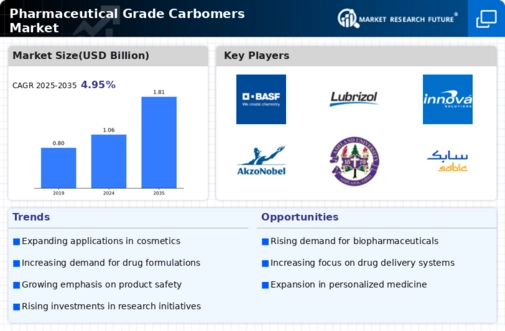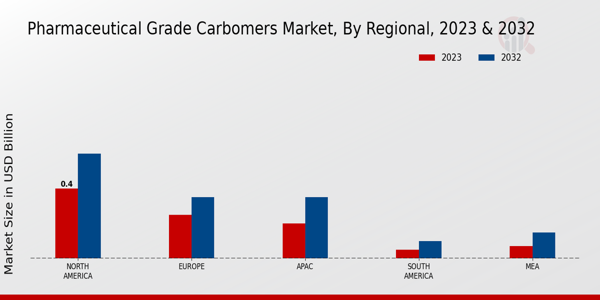Market Growth Projections
The Global Pharmaceutical Grade Carbomers Market Industry is projected to experience robust growth over the next decade. With a market value anticipated to reach 1.06 USD Billion in 2024 and further expand to 1.81 USD Billion by 2035, the industry is poised for significant development. The compound annual growth rate of 4.96% from 2025 to 2035 underscores the increasing reliance on pharmaceutical-grade carbomers in various applications, including topical formulations and biopharmaceuticals. This growth is indicative of the broader trends within the pharmaceutical sector, where the demand for high-quality excipients continues to rise.
Innovations in Drug Delivery Systems
The Global Pharmaceutical Grade Carbomers Market Industry is propelled by innovations in drug delivery systems, which increasingly incorporate advanced excipients like carbomers. These innovations aim to improve the efficacy and patient compliance of pharmaceutical products. For instance, the development of controlled-release formulations and nanocarrier systems often relies on the unique properties of carbomers to enhance drug solubility and stability. As pharmaceutical companies invest in research to develop novel delivery mechanisms, the demand for pharmaceutical-grade carbomers is expected to rise, aligning with the overall growth trajectory of the industry.
Expansion of the Pharmaceutical Sector
The Global Pharmaceutical Grade Carbomers Market Industry benefits from the continuous expansion of the pharmaceutical sector, particularly in emerging economies. Increased investment in research and development, coupled with the establishment of new manufacturing facilities, contributes to the rising demand for high-quality excipients like carbomers. As pharmaceutical companies strive to innovate and develop new formulations, the need for reliable and effective thickening agents becomes paramount. This trend is likely to drive the market growth, with projections indicating a market value of 1.81 USD Billion by 2035, showcasing the industry's potential.
Growing Demand for Topical Formulations
The Global Pharmaceutical Grade Carbomers Market Industry experiences a notable increase in demand for topical formulations, driven by the rising prevalence of skin disorders and the need for effective drug delivery systems. Carbomers serve as essential thickening agents in creams, gels, and ointments, enhancing the stability and efficacy of these products. As the global population ages, the incidence of dermatological conditions is expected to rise, further propelling the market. In 2024, the market is projected to reach 1.06 USD Billion, reflecting the growing consumer preference for topical treatments that utilize pharmaceutical-grade carbomers.
Rising Popularity of Biopharmaceuticals
The Global Pharmaceutical Grade Carbomers Market Industry is significantly impacted by the rising popularity of biopharmaceuticals, which often require specialized excipients for formulation. Carbomers are utilized in various biopharmaceutical applications, including protein-based drugs and vaccines, where they enhance stability and bioavailability. As the biopharmaceutical sector continues to expand, driven by advancements in biotechnology and increased investment in research, the demand for pharmaceutical-grade carbomers is likely to grow. This trend may contribute to a compound annual growth rate of 4.96% from 2025 to 2035, reflecting the evolving landscape of drug development.
Regulatory Support for Quality Standards
The Global Pharmaceutical Grade Carbomers Market Industry is positively influenced by stringent regulatory frameworks that emphasize quality and safety in pharmaceutical products. Regulatory bodies, such as the FDA and EMA, have established guidelines that necessitate the use of high-quality excipients, including pharmaceutical-grade carbomers, in drug formulations. This regulatory support not only ensures consumer safety but also encourages manufacturers to adopt superior quality standards. Consequently, the market is expected to witness steady growth, as compliance with these regulations becomes increasingly critical for pharmaceutical companies aiming to maintain their competitive edge.










